病理学名词中英文对照
- 格式:doc
- 大小:19.00 KB
- 文档页数:4
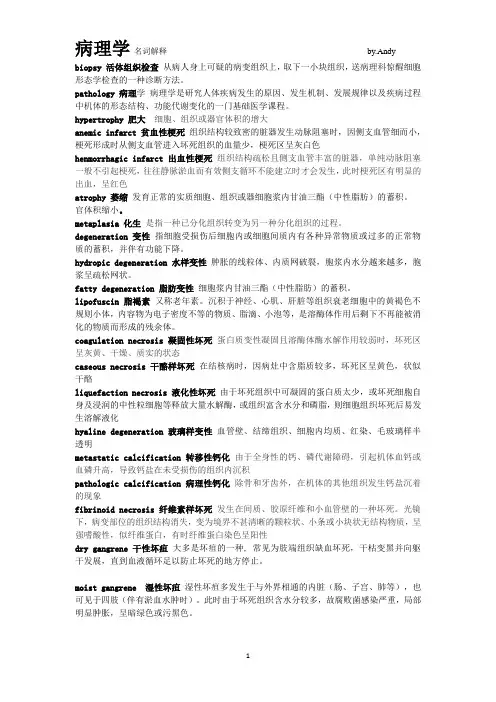
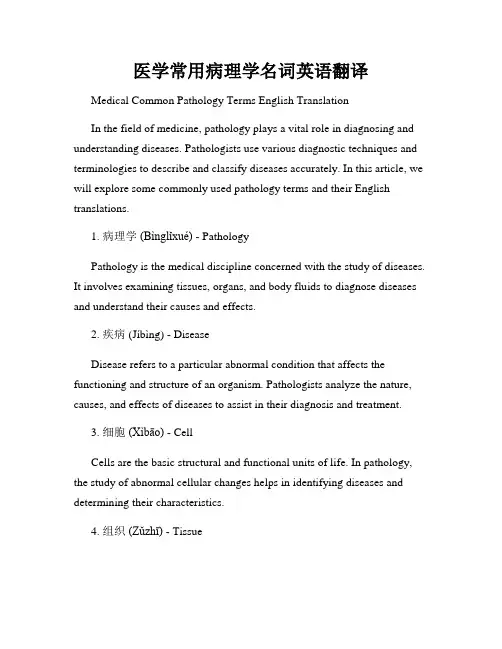
医学常用病理学名词英语翻译Medical Common Pathology Terms English TranslationIn the field of medicine, pathology plays a vital role in diagnosing and understanding diseases. Pathologists use various diagnostic techniques and terminologies to describe and classify diseases accurately. In this article, we will explore some commonly used pathology terms and their English translations.1. 病理学(Bìnglǐxué) - PathologyPathology is the medical discipline concerned with the study of diseases. It involves examining tissues, organs, and body fluids to diagnose diseases and understand their causes and effects.2. 疾病 (Jíbìng) - DiseaseDisease refers to a particular abnormal condition that affects the functioning and structure of an organism. Pathologists analyze the nature, causes, and effects of diseases to assist in their diagnosis and treatment.3. 细胞(Xìbāo) - CellCells are the basic structural and functional units of life. In pathology, the study of abnormal cellular changes helps in identifying diseases and determining their characteristics.4. 组织(Zǔzhī) - TissueTissues are groups of cells with similar structures and functions. Pathologists examine tissues to identify abnormal changes that may indicate pathology or disease.5. 肿瘤(Zhǒngliú) - TumorA tumor refers to an abnormal growth or mass of cells. Pathologists study tumors to determine their nature, whether they are benign (non-cancerous) or malignant (cancerous).6. 癌症 (Áizhèng) - CancerCancer is a disease characterized by the uncontrolled growth and spread of abnormal cells. Pathologists analyze cancer cells to identify their type, stage, and potential for metastasis.7. 炎症 (Yánzhèng) - InflammationInflammation is the body's protective response to injury, infection, or tissue damage. Pathologists examine inflammatory responses to diagnose and monitor various diseases.8. 溃疡 (Kuìyáng) - UlcerAn ulcer is a sore that forms when the skin or mucous membrane is damaged and does not heal. Pathologists study ulcers to identify their characteristics and underlying causes.9. 扩张(Kuòzhāng) - DilatationDilatation refers to the enlargement or expansion of organs, blood vessels, or other structures. Pathologists analyze these changes to identify associated diseases or conditions.10. 坏死(Huàisǐ) - NecrosisNecrosis is the death of cells or tissues caused by factors such as injury, infection, or insufficient blood supply. Pathologists examine necrotic tissues to investigate the causes and effects of cell death.11. 水肿(Shuǐzhǒng) - EdemaEdema is the excessive accumulation of fluid in the tissues, leading to swelling. Pathologists study edema to understand its causes and its significance in certain diseases.12. 结石 (Jiéshí) - CalculusCalculus refers to the formation of hard mineral deposits in organs or ducts, such as kidney stones or gallstones. Pathologists analyze these calculi to determine their composition and potential complications.13. 梗塞(Gěngsè) - InfarctionInfarction occurs when a blood clot or other obstruction blocks the blood supply to a specific tissue or organ, causing cell death. Pathologists investigate infarctions to understand their causes and effects.14. 纤维化(Xiānwéihuà) - FibrosisFibrosis is the excessive accumulation of fibrous connective tissue in response to damage or inflammation. Pathologists analyze fibrotic changes to evaluate disease progression and complications.15. 化脓 (Huàní) - SuppurationSuppuration refers to the formation or presence of pus in infected tissues or organs. Pathologists identify and analyze suppurative processes to diagnose and manage infectious diseases.16. 嗜酸性(Shìān Xìng) - EosinophilicEosinophilic describes the presence of eosinophils, a type of white blood cell, in certain tissues or fluids. Pathologists use this term to describe specific cellular changes in various diseases.These are just a few examples of common pathology terms and their English translations. The accurate translation and understanding of these terms are essential for medical professionals worldwide to communicate effectively and work collaboratively in diagnosing and treating diseases.。

病理学名词解释1.适应(Adaptation):指细胞、组织、器官和机体对于持续性的内外刺激做出的非损伤性反应。
2.肥大(Hypertrophy):细胞、组织或器官体积增大称为肥大。
组织、器官的肥大通常是由于实质细胞的肥大所致,可伴有细胞数量的增加3.增生(Hyperplasia):器官或组织的实质细胞数目增多称为增生。
增生可致组织、器官的体积增大。
4.萎缩(Atrophy):是已发育正常的实质细胞、组织或器官的体积缩小,萎缩的器官常伴有细胞数量的减少。
5.化生(Metaplasia):一种分化成熟的细胞转化为另一种分化成熟的性质相似的细胞的过程。
6.线粒体渗透性移位:线粒体损伤常导致线粒体内膜高导电性通道的形成,称为线粒体渗透性移位。
7.自由基:具有未配对外层电子的化学基团。
主要包括羟自由基(OH。
)、全羟自由基(HO2。
)、超氧离子(O2-)、CCl3。
自由基和不属于自由基的过氧化氢(H2O2)。
前三者称为活性氧基团。
8.髓鞘样结构(Myelin figure):是指细胞质膜和/或细胞器膜脂质片断的螺旋状或同心圆层状卷曲。
见于细胞不可逆损伤。
9.细胞水肿(cellular swelling):或称水变性(hydropic degeneration),是细胞损伤中最早出现的病变,系因线粒体受损ATP生成减少,细胞膜Na+-K+泵功能障碍而导致细胞内钠离子和水的过多积聚。
常见于缺氧、感染、中毒时心、肝、肾等器官的实质细胞。
9.脂肪变(Fatty change):中性脂肪(甘油三脂)蓄积于非脂肪细胞的细胞质中称为脂肪变,多发生于肝细胞、心肌细胞、肾小管上皮细胞等。
10.虎斑心:心肌脂肪变时,脂肪变的心肌呈黄色,与未受侵犯的红色心肌相间排列,形成状似虎皮的斑纹,称为“虎斑心”。
11.心肌脂肪浸润(fatty infiltration):指心外膜下有过多的脂肪并向心肌内伸入,心肌因受伸入脂肪组织的挤压而萎缩并显薄弱,称为心肌脂肪浸润。
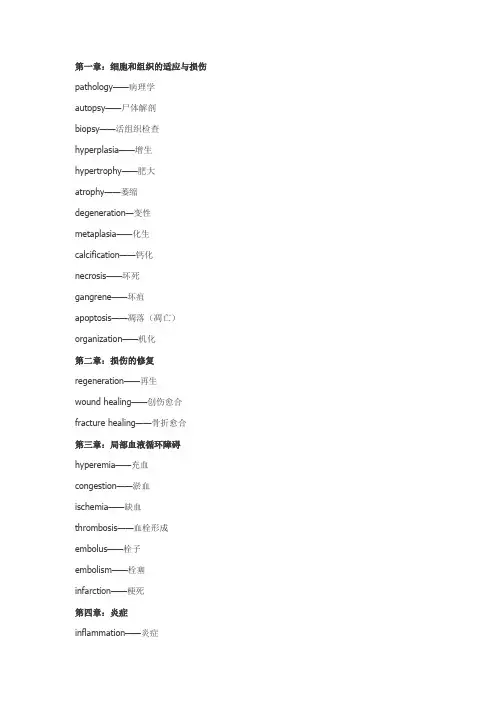
第一章:细胞和组织的适应与损伤pathology——病理学autopsy——尸体解剖biopsy——活组织检查hyperplasia——增生hypertrophy——肥大atrophy——萎缩degeneration—变性metaplasia——化生calcification——钙化necrosis——坏死gangrene——坏疽apoptosis——凋落(凋亡)organization——机化第二章:损伤的修复regeneration——再生wound healing——创伤愈合fracture healing——骨折愈合第三章:局部血液循环障碍hyperemia——充血congestion——淤血ischemia——缺血thrombosis——血栓形成embolus——栓子embolism——栓塞infarction——梗死第四章:炎症inflammation——炎症alteration——变质exudation——渗出proliferation——增生chronic granulomatous imflammation ——慢性肉芽肿性炎症fibrinous inflammation——纤维素性炎症suppurative or purulent inflammation ——化脓性炎abscess——脓肿第五章:肿瘤tumor,neoplasm——肿瘤atypia——异型性metastasis——转移carcinoma——癌sarcoma——肉瘤adenocarcinoma—腺癌lipoma---脂肪瘤fibrosarcoma----纤维肉瘤第六章:心血管系统疾病atherosclerosis——动脉粥样硬化benign hypertension——良性高血压rheumatism——风湿病subacute infective endocarditis ——亚急性感染性心内膜炎myocardial infarction——心肌梗死第七章:呼吸系统疾病chronic bronchitis——慢性支气管炎emphysema——肺气肿lobar pneumonia——大叶性肺炎silicosis——矽肺第八章:消化系统疾病gastritis——胃炎viral hepatitis——病毒性肝炎liver cirrhosis——肝硬化第九章:淋巴造血系统病第十章:免疫性疾病哈哈,也没有哟~第十一章:泌尿系统疾病glomerulonephritis——肾小球肾炎crescent——新月体pyelonephritis——肾盂肾炎hydronephrosis——肾盂积水第十二章:生殖系统和乳腺疾病hydatidiform mole——水泡状胎块(葡萄胎)choriocarcinoma——绒毛膜癌第十三章:内分泌系统病啦啦啦~有没有耶~第十四章:神经系统疾病meningitis——脑膜炎epidemic encephalitis B——流行性乙型脑炎第十五章:传染病tuberculosis——结核病typhoid fever——伤寒bacillary dysentery——细菌性痢疾syphilid——梅毒疹第十六章:寄生虫病amoebiasis——阿米巴病schistosomiasis——血吸虫病。
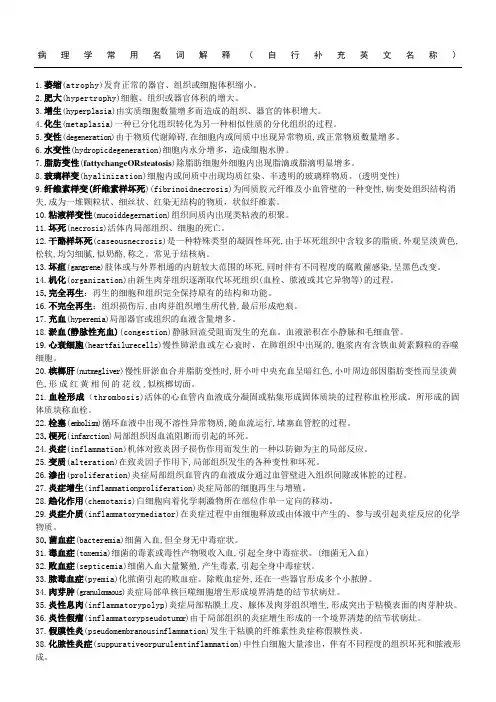
病理学常用名词解释(自行补充英文名称)1.萎缩(atrophy)发育正常的器官、组织或细胞体积缩小。
2.肥大(hypertrophy)细胞、组织或器官体积的增大。
3.增生(hyperplasia)由实质细胞数量增多而造成的组织、器官的体积增大。
4.化生(metaplasia)一种已分化组织转化为另一种相似性质的分化组织的过程。
5.变性(degeneration)由于物质代谢障碍,在细胞内或间质中出现异常物质,或正常物质数量增多。
6.水变性(hydropicdegeneration)细胞内水分增多,造成细胞水肿。
7.脂肪变性(fattychangeORsteatosis)除脂肪细胞外细胞内出现脂滴或脂滴明显增多。
8.玻璃样变(hyalinization)细胞内或间质中出现均质红染、半透明的玻璃样物质。
(透明变性)9.纤维素样变(纤维素样坏死)(fibrinoidnecrosis)为间质胶元纤维及小血管壁的一种变性,病变处组织结构消失,成为一堆颗粒状、细丝状、红染无结构的物质,状似纤维素。
10.粘液样变性(mucoiddegernation)组织间质内出现类粘液的积聚。
11.坏死(necrosis)活体内局部组织、细胞的死亡。
12.干酪样坏死(caseousnecrosis)是一种特殊类型的凝固性坏死,由于坏死组织中含较多的脂质,外观呈淡黄色,松软,均匀细腻,似奶酪,称之。
常见于结核病。
13.坏疽(gangrene)肢体或与外界相通的内脏较大范围的坏死,同时伴有不同程度的腐败菌感染,呈黑色改变。
14.机化(organization)由新生肉芽组织逐渐取代坏死组织(血栓、脓液或其它异物等)的过程。
15.完全再生:再生的细胞和组织完全保持原有的结构和功能。
16.不完全再生:组织损伤后,由肉芽组织增生所代替,最后形成疤痕。
17.充血(hyperemia)局部器官或组织的血液含量增多。
18.淤血(静脉性充血)(congestion)静脉回流受阻而发生的充血。
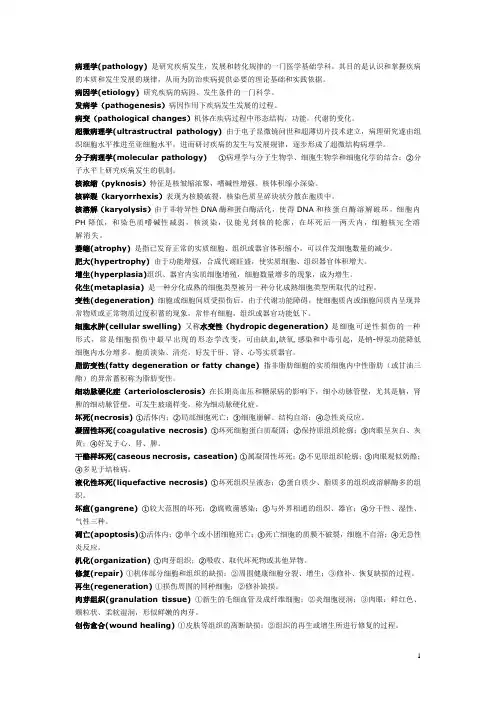
病理学(pathology)是研究疾病发生,发展和转化规律的一门医学基础学科。
其目的是认识和掌握疾病的本质和发生发展的规律,从而为防治疾病提供必要的理论基础和实践依据。
病因学(etiology)研究疾病的病因、发生条件的一门科学。
发病学(pathogenesis)病因作用下疾病发生发展的过程。
病变(pathological changes)机体在疾病过程中形态结构,功能,代谢的变化。
超微病理学(ultrastructral pathology)由于电子显微镜问世和超薄切片技术建立,病理研究遂由组织细胞水平推进至亚细胞水平,进而研讨疾病的发生与发展规律,逐步形成了超微结构病理学。
分子病理学(molecular pathology)①病理学与分子生物学、细胞生物学和细胞化学的结合;②分子水平上研究疾病发生的机制。
核浓缩(pyknosis)特征是核皱缩浓聚,嗜碱性增强。
核体积缩小深染。
核碎裂(karyorrhexis)表现为核膜破裂,核染色质呈碎块状分散在胞质中。
核溶解(karyolysis)由于非特异性DNA酶和蛋白酶活化,使得DNA和核蛋白酶溶解破坏,细胞内PH降低,和染色质嗜碱性减弱,核淡染,仅能见到核的轮廓,在坏死后一两天内,细胞核完全溶解消失。
萎缩(atrophy)是指已发育正常的实质细胞、组织或器官体积缩小,可以伴发细胞数量的减少。
肥大(hypertrophy)由于功能增强,合成代谢旺盛,使实质细胞、组织器官体积增大。
增生(hyperplasia)组织、器官内实质细胞增殖,细胞数量增多的现象,成为增生。
化生(metaplasia)是一种分化成熟的细胞类型被另一种分化成熟细胞类型所取代的过程。
变性(degeneration)细胞或细胞间质受损伤后,由于代谢功能障碍,使细胞质内或细胞间质内呈现异常物质或正常物质过度积蓄的现象,常伴有细胞,组织或器官功能低下。
细胞水肿(cellular swelling)又称水变性(hydropic degeneration)是细胞可逆性损伤的一种形式,常是细胞损伤中最早出现的形态学改变,可由缺血,缺氧,感染和中毒引起,是钠-钾泵功能降低细胞内水分增多,胞质淡染、清亮,好发于肝、肾、心等实质器官。
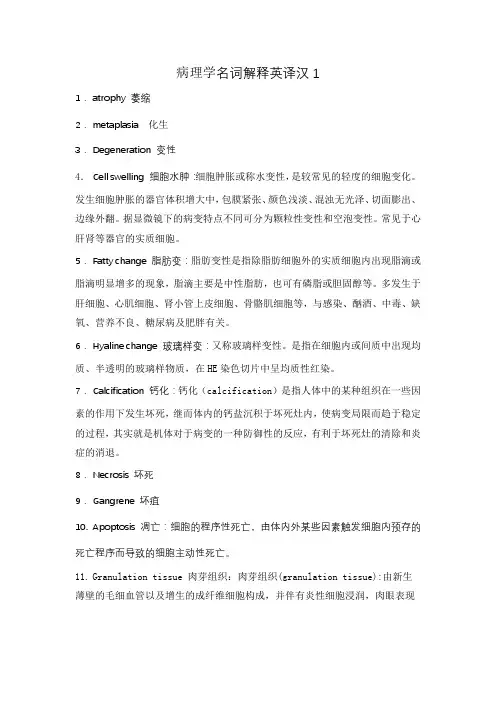
病理学名词解释英译汉1
1.atrophy 萎缩
2.metaplasia 化生
3.Degeneration 变性
4.Cell swelling 细胞水肿:细胞肿胀或称水变性,是较常见的轻度的细胞变化。
发生细胞肿胀的器官体积增大中,包膜紧张、颜色浅淡、混浊无光泽、切面膨出、边缘外翻。
据显微镜下的病变特点不同可分为颗粒性变性和空泡变性。
常见于心肝肾等器官的实质细胞。
5.Fatty change 脂肪变:脂肪变性是指除脂肪细胞外的实质细胞内出现脂滴或脂滴明显增多的现象,脂滴主要是中性脂肪,也可有磷脂或胆固醇等。
多发生于肝细胞、心肌细胞、肾小管上皮细胞、骨骼肌细胞等,与感染、酗酒、中毒、缺氧、营养不良、糖尿病及肥胖有关。
6.Hyaline change 玻璃样变:又称玻璃样变性。
是指在细胞内或间质中出现均质、半透明的玻璃样物质,在HE染色切片中呈均质性红染。
7.Calcification 钙化:钙化(calcification)是指人体中的某种组织在一些因素的作用下发生坏死,继而体内的钙盐沉积于坏死灶内,使病变局限而趋于稳定的过程,其实就是机体对于病变的一种防御性的反应,有利于坏死灶的清除和炎症的消退。
8.Necrosis 坏死
9.Gangrene 坏疽
10.Apoptosis 凋亡:细胞的程序性死亡,由体内外某些因素触发细胞内预存的死亡程序而导致的细胞主动性死亡。
11.Granulation tissue 肉芽组织:肉芽组织(granulation tissue):由新生薄壁的毛细血管以及增生的成纤维细胞构成,并伴有炎性细胞浸润,肉眼表现。
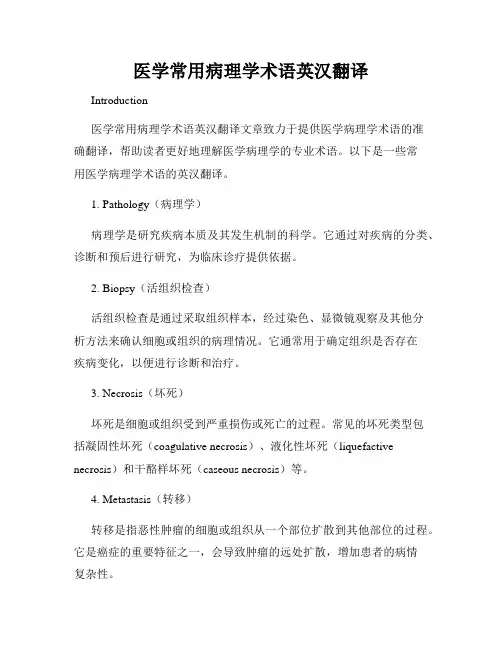
医学常用病理学术语英汉翻译Introduction医学常用病理学术语英汉翻译文章致力于提供医学病理学术语的准确翻译,帮助读者更好地理解医学病理学的专业术语。
以下是一些常用医学病理学术语的英汉翻译。
1. Pathology(病理学)病理学是研究疾病本质及其发生机制的科学。
它通过对疾病的分类、诊断和预后进行研究,为临床诊疗提供依据。
2. Biopsy(活组织检查)活组织检查是通过采取组织样本,经过染色、显微镜观察及其他分析方法来确认细胞或组织的病理情况。
它通常用于确定组织是否存在疾病变化,以便进行诊断和治疗。
3. Necrosis(坏死)坏死是细胞或组织受到严重损伤或死亡的过程。
常见的坏死类型包括凝固性坏死(coagulative necrosis)、液化性坏死(liquefactive necrosis)和干酪样坏死(caseous necrosis)等。
4. Metastasis(转移)转移是指恶性肿瘤的细胞或组织从一个部位扩散到其他部位的过程。
它是癌症的重要特征之一,会导致肿瘤的远处扩散,增加患者的病情复杂性。
5. Inflammation(炎症)炎症是身体对组织损伤或异物侵入的非特异性反应。
它涉及到免疫细胞的介入和炎性介质的释放,通常表现为红肿、疼痛和局部温度升高等症状。
6. Hyperplasia(增生)增生是指细胞数量的增加,可以导致组织或器官的增大。
它通常是一种可逆的病理过程,而不像癌症中的肿瘤增殖那样无止境。
7. Dysplasia(异型增生)异型增生是一种细胞形态异常的病理过程,可能是癌前病变的早期指标之一。
它通常表现为细胞形态的不规则和异常,但尚未具备恶性肿瘤的特征。
8. Carcinoma(癌症)癌症是恶性肿瘤的一种类型,其中细胞无法进行正常的调控和分化。
它可以发生在不同的组织和器官,如肺癌、乳腺癌等。
9. Sarcoma(肉瘤)肉瘤是一种恶性肿瘤,起源于身体的结缔组织,如骨髓、肌肉或软组织。
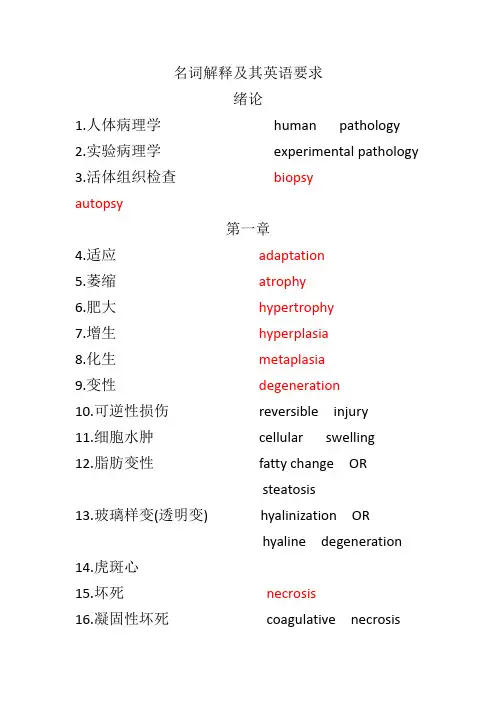
名词解释及其英语要求绪论1.人体病理学human pathology2.实验病理学experimental pathology3.活体组织检查biopsyautopsy第一章4.适应adaptation5.萎缩atrophy6.肥大hypertrophy7.增生hyperplasia8.化生metaplasia9.变性degeneration10.可逆性损伤reversible injury11.细胞水肿cellular swelling12.脂肪变性fatty change ORsteatosis13.玻璃样变(透明变) hyalinization ORhyaline degeneration14.虎斑心15.坏死necrosis16.凝固性坏死coagulative necrosis17.干酪样坏死caseous necrosis18.液化性坏死liquefactive necrosis19.脂肪坏死fat necrosis20.坏疽gangrene21.病理性钙化pathologic calcification22.营养不良性钙化dystrophic calcification23.转移性钙化metastatic calcification24.机化organization25.包裹encapsulation26.调亡apoptosis第二章27.修复repair28.再生regeneration29.完全再生30.纤维性修复31.不稳定细胞labile cells32.稳定细胞stable cells33.永久性细胞permanent cells34.生长因子growth factor35.接触性抑制contact inhibition36.肉芽组织granulation tissue37.瘢痕组织scar tissue38.一期愈合healing by first intention39.二期愈合healing by second intention40.暂时性骨痂41.编制骨woven bone第三章42.瘀血congestion43.肺褐色硬化brown duration44.心力衰竭细胞heart failure cells45.槟榔肝nutmeg liver46.血栓形成thrombosis47.白色血栓pale thrombus48.混合血栓mixed thrombus49.透明血栓hyaline thrombus50.再通recanalization51.栓塞embolism52.梗死infarction53.出血性梗死hemorrhagic infarct54.贫血性梗死anemic infarct55.败血型梗死septic infarct56.脂肪栓塞fat embolism57.气体栓塞gas embolism58.交叉性栓塞crossed embolism59.羊水栓塞amniotic fluid embolism第四章60.炎症inflammation61.变质alteration62.渗出exudation63.血流停滞stasis64.穿胞作用transcytosis65.趋化作用chmotaxis66.吞噬作用67.调理素opsonin68.炎症介质inflammatory mediator69.浆液性炎serous inflammation70.卡他catarrh71.纤维素性炎fibrinous inflammation72.伪膜性炎73.化脓性炎suppurative or purulent inflammation脓液pus脓细胞74.蜂窝织炎phlegmonous inflammation75.脓肿abscess76.出血性炎hemorrhagic inflammation77.毒血症toxemia78.菌血症bacteremia79.败血症septicemia80.脓毒败血症pyemia81.窦道sinus82.瘘管fistula83.肉芽肿性炎chronic granulomatous inflammation84.炎性息肉及炎性假瘤85.异物巨细胞第五章86.肿瘤tumor OR neoplasm87.异型性atypia88.肿瘤的分化differentiation89.间变analasia90.癌cancer91.肉瘤sarcoma92.膨胀性生长expansile growth93.外生性生长exophytic growth94.浸润性生长invasive growth95.肿瘤的演进progression96.肿瘤的异质性heterogeneity97.生长分数growth fraction98.直接蔓延direct spreading99.转移metastasis100.种植性转移implantation metastasis 101.恶病质cancer cachexia102.副肿瘤综合征paraneoplastic syndrome 103.交界性肿瘤borderline tumor 104.囊腺瘤cystadenoma105.角化珠keratin pearl106.胶样癌(粘液癌) colloid carcinoma107.印戒细胞signet-ring cell108.癌前病变(疾病)precancerous lesion(disease) 109.非典型增生atypical hyperplasia 110.原位癌CIS111.癌基因oncogene112.肿瘤抑制基因tumor suppressor gene 113.Codman三角114.日光放射状阴影115.视网膜母细胞瘤rentinoblastoma116.恶性黑色素瘤malignant melanoma第六章117.动脉粥样硬化atherosclerosis118.泡沫细胞119.粥样斑块atheromatous plague120.AS性肾固缩121.冠状动脉性心脏病CHD122.心绞痛angina pectoris123.心肌梗死myocardial infarction MI 124.心内膜下心肌梗死subendocardial MI 125.透壁性心肌梗死transmural MI 126.环状梗死circumferential infarction 127.室壁瘤ventricular aneurysm 128.冠状动脉性猝死sudden coronary death 129.原发性高血压primary hypertension 130.心脏向心性肥大concentric hypertrophy 131.原发性颗粒性固缩肾primary granularatrophy of the kidney 132.高血压脑病hypertensive encephalopathy 133.脑软化softening of brain 134.急进性高血压accelerated hypertension 135.增生性小动脉硬化hyperplastic arteriolosclerosis 136.坏死性细动脉炎necrotizing arteriolitis 137.风湿病rheumatism138.风湿细胞Aschoff body(cell) 139.疣状赘生物verrucous vegetation 140.MacCallum斑141.绒毛心cor villosum142.环形红斑erythema annulare 143.亚急性感染性心内膜炎subacute infectiveendocarditis144.急性感染性心内膜炎acute infectiveendocarditis145.心瓣膜病valvular disease VD第七章146.大叶性肺炎Lobar pneumonia 147.红色肝样变148.灰色肝样变149.肺肉质变pulmonary carnification 150.小叶性肺炎lobular pneumonia 151.透明膜152.慢性阻塞性肺疾病COPD153.肺气肿pulmonary emphysema 154.肺心病chronic cor pulmonale 155.硅结节silicotic156.隐性肺癌carcinoma of the lung 157.燕麦细胞癌158.泡状核细胞癌vesicular nucleus cellcarcinoma第八章159.肠上皮化生intestinal metaplasia 160.假幽门腺化生161.幽门梗阻162.胞浆疏松化163.气球样变164.嗜酸性变165.嗜酸性坏死166.点状坏死spotty necrosis 167.桥接坏死bridging necrosis 168.碎片状坏死piecemeal necrosis 169.毛玻璃样肝细胞170.肝硬化liver cirrhosis 171.假小叶172.海蛇头现象caput medusa 173.羽毛状坏死174.Barrett食管175.早期食管癌176.早期胃癌177.进展期胃癌178.革囊胃179.Krukenberg瘤180.早期肝癌第九章181.淋巴组织肿瘤lymphoid neoplasms 182.恶性淋巴瘤malignant lymphoma 183.霍奇金淋巴瘤HL184.镜影细胞mirror image cell 185.陷窝细胞lacunar cell186.爆米花细胞(L&H细胞) lymphohistiocyticvariant187.白血病leukemia188.绿色瘤chloroma第十章189.自身免疫性疾病autoimmune disease 190.系统性红斑狼疮SLE191.狼疮小体(苏木素小体)192.狼疮细胞193.狼疮带194.类风湿性关节炎rheumatoid arthritis 195.血管翳pannus196.类风湿小节rheumatoid nodule 197.免疫缺陷病immunodeficiency disease 198.艾滋病AIDS第十一章199.肾小球肾炎glomerulonephritis 200.急性肾炎综合征acute nephritic syndrome 201.急进性肾炎综合征rapidly progressivenephritic syndrome 202.肾病综合征nephritic syndrome203.慢性肾炎综合征chronic nephritic syndrome 204.氮质血症azotemia205.尿毒症uremia206.大红肾(蚤咬肾)207.新月体crescent208.大白肾209.微小病变性肾小球肾炎minimal changeglomerulopathy (脂性肾病lipoidnephrosis)210.继发性颗粒性固缩肾211.胶样管型第十二章212.纳博特囊肿Nabothian cyst 213.子宫颈真性糜烂214.子宫颈假性糜烂215.子宫颈上皮内瘤变CIN216.子宫颈上皮非典型增生cervical epithelialdysplasia217.子宫颈原位癌carcinoma in situ 218.微小浸润性鳞癌microinvasive squamouscell carcinoma 219.葡萄胎hydatidiform mole 220.细胞滋养层细胞syncytiotrophblast 221.合体滋养层细胞cyyotrophoblast 222.侵蚀性葡萄胎invasive mole 223.绒毛膜癌choriocarcinoma 224.畸胎瘤225.粉刺癌comedocatcinoma 226.小叶内原位癌lobular carcinoma in situ 227.非粉刺型导管癌noncomedo intraductalcarcinoma228.浸润性导管癌invasive ductal carcinoma 229.浸润性小叶癌invasive lobular carcinoma第十三章230.弥漫性非毒性甲状腺肿diffuse nontoxic goiter 231.胶样甲状腺肿diffuse colloid goiter 232.结节性甲状腺肿nodular goiter233.弥漫性毒性甲状腺肿diffuse toxic goiter 234.乳头状癌papillary carcinoma 235.滤泡癌follicular carcinoma 236.髓样癌medullary carcinoma 237.未分化癌undifferentiated carcinoma 238.糖尿病diabetes mellitus第十四章239.噬神经细胞现象neuronophagia 240.卫星现象satellitosis241.小胶质细胞结节microglial nodule 242.血管套(淋巴细胞套)243.镂空筛网状病灶244.格子细胞gitter cell245.脑疝herniation246.脑水肿brain edema 247.脑积水hydrocephalus248.Alzheimer病249.老年斑250.神经原纤维缠结251.颗粒空泡变性252.Hirano小体253.Parkinson病254.Lewy小体第十五章255.结核结节tubercle256.上皮样细胞257.肺原发综合征258.浸润性肺结核259.干酪性肺炎260.结核球tuberculoma 261.冷脓肿262.伤寒肉芽肿typhoid granuloma 263.树胶肿。
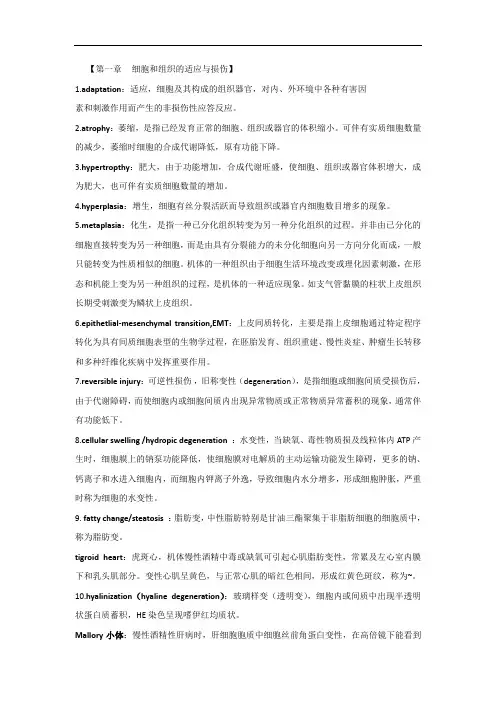
【第一章细胞和组织的适应与损伤】1.adaptation:适应,细胞及其构成的组织器官,对内、外环境中各种有害因素和刺激作用而产生的非损伤性应答反应。
2.atrophy:萎缩,是指已经发育正常的细胞、组织或器官的体积缩小。
可伴有实质细胞数量的减少,萎缩时细胞的合成代谢降低,原有功能下降。
3.hypertropthy:肥大,由于功能增加,合成代谢旺盛,使细胞、组织或器官体积增大,成为肥大,也可伴有实质细胞数量的增加。
4.hyperplasia:增生,细胞有丝分裂活跃而导致组织或器官内细胞数目增多的现象。
5.metaplasia:化生,是指一种已分化组织转变为另一种分化组织的过程。
并非由已分化的细胞直接转变为另一种细胞,而是由具有分裂能力的未分化细胞向另一方向分化而成,一般只能转变为性质相似的细胞。
机体的一种组织由于细胞生活环境改变或理化因素刺激,在形态和机能上变为另一种组织的过程,是机体的一种适应现象。
如支气管黏膜的柱状上皮组织长期受刺激变为鳞状上皮组织。
6.epithetlial-mesenchymal transition,EMT:上皮间质转化,主要是指上皮细胞通过特定程序转化为具有间质细胞表型的生物学过程,在胚胎发育、组织重建、慢性炎症、肿瘤生长转移和多种纤维化疾病中发挥重要作用。
7.reversible injury:可逆性损伤,旧称变性(degeneration),是指细胞或细胞间质受损伤后,由于代谢障碍,而使细胞内或细胞间质内出现异常物质或正常物质异常蓄积的现象,通常伴有功能低下。
8.cellular swelling /hydropic degeneration:水变性,当缺氧、毒性物质损及线粒体内ATP产生时,细胞膜上的钠泵功能降低,使细胞膜对电解质的主动运输功能发生障碍,更多的钠、钙离子和水进入细胞内,而细胞内钾离子外逸,导致细胞内水分增多,形成细胞肿胀,严重时称为细胞的水变性。
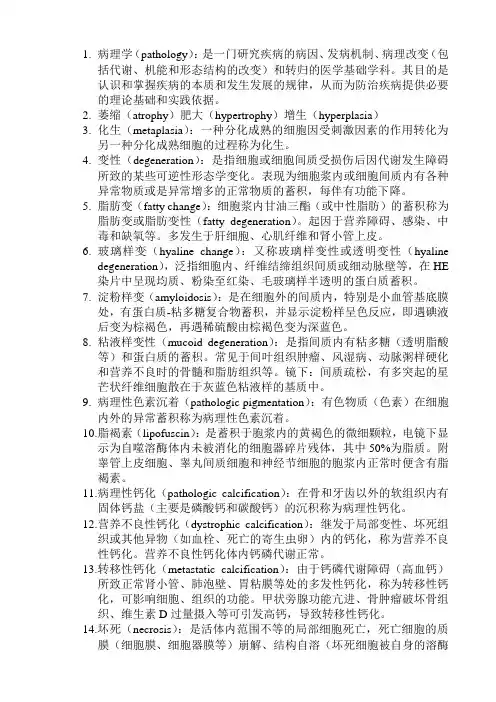
1.病理学(pathology):是一门研究疾病的病因、发病机制、病理改变(包括代谢、机能和形态结构的改变)和转归的医学基础学科。
其目的是认识和掌握疾病的本质和发生发展的规律,从而为防治疾病提供必要的理论基础和实践依据。
2.萎缩(atrophy)肥大(hypertrophy)增生(hyperplasia)3.化生(metaplasia):一种分化成熟的细胞因受刺激因素的作用转化为另一种分化成熟细胞的过程称为化生。
4.变性(degeneration):是指细胞或细胞间质受损伤后因代谢发生障碍所致的某些可逆性形态学变化。
表现为细胞浆内或细胞间质内有各种异常物质或是异常增多的正常物质的蓄积,每伴有功能下降。
5.脂肪变(fatty change):细胞浆内甘油三酯(或中性脂肪)的蓄积称为脂肪变或脂肪变性(fatty degeneration)。
起因于营养障碍、感染、中毒和缺氧等。
多发生于肝细胞、心肌纤维和肾小管上皮。
6.玻璃样变(hyaline change):又称玻璃样变性或透明变性(hyalinedegeneration),泛指细胞内、纤维结缔组织间质或细动脉壁等,在HE 染片中呈现均质、粉染至红染、毛玻璃样半透明的蛋白质蓄积。
7.淀粉样变(amyloidosis):是在细胞外的间质内,特别是小血管基底膜处,有蛋白质-粘多糖复合物蓄积,并显示淀粉样呈色反应,即遇碘液后变为棕褐色,再遇稀硫酸由棕褐色变为深蓝色。
8.粘液样变性(mucoid degeneration):是指间质内有粘多糖(透明脂酸等)和蛋白质的蓄积。
常见于间叶组织肿瘤、风湿病、动脉粥样硬化和营养不良时的骨髓和脂肪组织等。
镜下:间质疏松,有多突起的星芒状纤维细胞散在于灰蓝色粘液样的基质中。
9.病理性色素沉着(pathologic pigmentation):有色物质(色素)在细胞内外的异常蓄积称为病理性色素沉着。
10.脂褐素(lipofuscin):是蓄积于胞浆内的黄褐色的微细颗粒,电镜下显示为自噬溶酶体内未被消化的细胞器碎片残体,其中50%为脂质。
常见病理学术语的中英文解释病理学术语是病理学领域的重要组成部分,对于医学研究和临床诊断具有重要意义。
本文将介绍一些常见的病理学术语的中英文解释。
1. 细胞增生(Cell proliferation)细胞增生是指细胞数量的增加,通常由于细胞分裂或细胞增加活跃而导致。
这是一种正常的生理反应,但在某些情况下也可能与疾病相关。
2. 细胞凋亡(Cell apoptosis)细胞凋亡是指细胞按照程序性死亡过程自行死亡。
细胞凋亡在正常生理过程中起着重要作用,但在疾病发展中也可能发生异常。
3. 肿瘤(Tumor)肿瘤是指体内异常增殖的细胞或组织结构的集合体,可以分为良性和恶性两类。
良性肿瘤生长缓慢,不具有侵袭性和转移性;恶性肿瘤则有侵袭和转移的倾向。
4. 癌症(Cancer)癌症是一类恶性肿瘤的统称,它常常具有侵袭性、浸润性和转移性。
癌症的治疗方法多样,包括手术切除、化疗、放疗等。
5. 炎症(Inflammation)炎症是机体对损伤和感染的免疫防御反应,表现为红、肿、热、痛等症状。
炎症是机体恢复的重要过程,但在某些情况下也可能导致组织损伤。
6. 溶解(Dissolution)溶解是指原本结合在一起的物质逐渐解离,转变为溶剂中的溶质的过程。
在病理学中,溶解可以指细胞内或细胞外的化学物质分解的过程。
7. 坏死(Necrosis)坏死是指细胞或组织的死亡,通常是由于缺血、感染、毒素等因素引起。
坏死的特征包括细胞浑浊、溶解等,与凋亡有所不同。
8. 梗死(Infarction)梗死是指由于血液供应中断而导致组织坏死的情况。
常见的梗死包括心肌梗死、脑梗死等。
9. 肉眼观察(Gross examination)肉眼观察是指对切除的组织标本或尸检标本进行直接观察和描述。
通过肉眼观察,可以初步了解病变的形态、大小等特征。
10. 组织学(Histology)组织学是研究组织结构、组织器官构成和功能的学科。
通过对组织标本染色和显微镜观察,可以了解组织细胞的形态、结构和功能的变化。
病理学名词中英文解释(损伤,修复,局部血液循环障碍,炎症,肿瘤)损伤injury1.萎缩(atrophy):是指已发育正常的实质细胞、组织、器官的体积缩小。
常表现为实质细胞体积变小或数目减少,而间质增生。
Atrophy is reduced size of an organ or tissue resulting from a decrease in cell size and number.2.肥大(hypertrophy):细胞、组织和器官体积的增大。
Hyperplasia is an increase in the numberof cells in an organ or tissue, usually resulting in increased mass of the organ or tissue.3.增生(hyperplasia):实质细胞的增多,可导致组织器官的增大。
Hypertrophy refers to an increasein the size of cells, resulting in an increase in the size of the organ.4.化生(metaplasia):一种分化成熟的细胞受刺激因素作用转化为另一种分化成熟细胞的过程。
Metaplasia is a reversible change in which one differentiated cell type (epithelial or mesenchymal) is replaced by another cell type.5.变性(degeneration):是指细胞或细胞间质受损伤后因代谢发生障碍所致的某些可逆性形态学变化。
表现为细胞浆内或间质中出现异常物质或正常物质异常增多。
accumulate substances in abnormal which can be Intracellular and/or Extracellular.Normal substances: increase Exogenous materials: appearance6.细胞水肿(cellular swelling):致病因素使细胞内水分的异常增多,形成细胞水肿。
病理学词汇中英对照小编为大家整理了病理学词汇中英对照,希望对你有帮助哦! pathology 病理学rheumatism 风湿症symptom 症状syphilis (lues) 梅毒teratoma 畸胎瘤thromboembolism 血栓栓塞thrombosis 血栓形成thrombus 血栓sarcoma 肉瘤scar 瘢痕,疤痕sclerosis 硬化septicemia 败血症serous cystadenoma 浆液性囊腺瘤shock 休克silicosis 矽肺acidophilic body 嗜酸小体acute inflammation 急性炎症acute proliferative glomerulonephritis 急性增殖性肾小球肾炎acute viral hepatitis 急性病毒性肝炎adenocarcinoma 腺癌adenoma 腺瘤air embolism 空气栓塞alteration 变质alterative inflammation 变质性炎症alveolar carcinoma 肺泡上皮癌amebic dysentery 阿米巴痢疾Amoebiasisamyloid degeneration 淀粉样变性anaplasia 间变anemic infarct 贫血性梗死anterior poliomyelitis 脊髓前角灰质炎apoptosis 程序性细胞死亡,凋落,凋亡appendicitis 阑尾炎arterial hyperemia 动脉性充血arteriolosclerosis 细动脉硬化arteriosclerotic heart disease 动脉硬化性心脏病Aschoff bodyatheroma 粥肿atherosclerosis 动脉粥样硬化atrophic gastritis 萎缩性胃炎atrophy 萎缩atypia 异型性autopsy 尸体解剖bacillary dysentery 细菌性痢疾bacteremia 菌血症bacterial endocarditis 细菌性心内膜炎bacterial pneumonia 细菌性肺炎benign tumor 良性肿瘤biopsy 活组织检查bridging necrosis 桥状坏死bronchial asthma 支气管哮喘bronchiectasis 支气管扩张,支气管扩张症bronchopneumonia 支气管肺炎Burkitt lymphoma Burkitt淋巴瘤cachexia 恶病质,恶液质carcinoid 类癌?carcinoma 癌carcinoma of thyroid 甲状腺癌cardiomyopathy 心肌病carnification 肉质变?caseous necrosis 干酪样坏死?caseous pneumonia 干酪性肺结核cavity 空洞degeneration 变性,溃变?diffuse glomerulonephritis 弥漫性肾小球肾炎disease 疾病?dry gangrene 干性坏疽?duodenal ulcer 十二指肠溃疡dysplasia 发育不良?edema 水肿embolism 栓塞?embolus 栓子?emphysema 肺气肿encapsulation 包围?endemic goiter 地方性甲状腺肿? endocardium 心内膜?epidemic meningitis 流行性脑膜炎? epithelioid cell 类上皮细胞?erosion 侵蚀etiology 病原学?external hemorrhage 外出血?exudate 渗出液?exudation 渗血fat embolism 脂肪栓塞fatty degeneration 脂肪变性?fibrin 纤维蛋白fibrinoid degeneration 纤维素样变性?fibrinoid necrosis 纤维素样坏死? fibroadenoma 纤维腺瘤?fibroma 纤维瘤fibrosarcoma 纤维肉瘤?follicular adenocarcinoma 滤泡腺癌? foreign body giant cell 异物巨细胞? gangrene 坏疽gas gangrene 气性坏疽?gastritis 胃炎?giant cell tumor 巨细胞瘤?goiter 甲状腺肿granular atrophic kidney 颗粒性萎缩肾granulation tissue 肉芽组织?hairy cell leukemia 毛细胞白血病?heartheart failure 心力衰竭hemorrhage 出血hemorrhagic infarct 出血性梗死? hemosiderin 含铁血黄素,血铁黄蛋白hyaline degeneration 玻璃样变性? hyaline membrane 透明膜?hydropic degeneration 水性肿胀(水样变性) hyperplasia 增生hypertension 高血压hypertrophic cardiomyopathy 肥厚型心肌病hypertrophy 肥厚infarct 梗死?infectious hepatitis 传染性肝炎? infiltration 浸润?inflammation 炎症inflammatory polyp 炎性息肉?injury 损伤internal hemorrhage 内出血?ischemic necrosis 贫血性坏死?left ventricle 左心室?leiomyoma 平滑肌瘤?leiomyosarcoma 平滑肌肉瘤?lesion 病变?leukemoid reaction 类白血病反应lipoma 脂肪瘤?liposarcoma 脂肪肉瘤liquefactive necrosis 液化性坏死?lobar pneumonia 大叶性肺炎lobular pneumonia 小叶性肺炎?lymphoma 淋巴瘤macronodular cirrhosis 大结节性肝硬变malignant histiocytosis 恶性组织细胞增生症malignant tumor 恶性肿瘤medullary carcinoma 髓样癌melanin 黑色素melanoma 黑色素瘤membranous glomerulonephritis 膜性肾小球肾炎metaplasia 化生metastasis 转移micronodular cirrhosis 小结节性肝硬变mixed tumor 混合瘤moist gangrene 湿性坏疽mucinous cystadenoma 粘液性囊腺瘤mycoplasma pneumonia 支原体肺炎myeloma 骨髓瘤myocardial infarction 心肌梗塞myocardium 心肌myoma 肌瘤myxoma 粘液瘤necrosis 坏死nephritic syndrome 肾病综合征nephrosclerosis 肾硬化neuroblastoma 神经母细胞瘤neurofibroma 神经纤维瘤neurotic atrophy 神经性萎缩oncogene 癌基因,原癌基因organization 机化osteoma 骨瘤osteosarcoma 骨肉瘤pale infarct 白色梗死papilloma 乳头状瘤pathogenesis 发病学pathologic anatomy 病理解剖学pathologic atrophy 病理性萎缩pathology 病理学peptic ulcer 消化性溃疡pericarditis 心包炎pericardium 心包physiologic atrophy 生理性萎缩piecemeal necrosis 碎片状坏死pituitary adenoma 垂体腺瘤polypoid adenoma 息肉状腺瘤primary complex 原发综合征proliferation 增殖pulmonary abscess 肺脓肿pulmonary emphysema 肺气肿pulmonary tuberculosis 肺结核pyelonephritis 肾盂肾炎rapidly progressive glomerulonephritis 急进性肾小球肾炎red infarct 红色梗死regeneration 再生repair 修复rheumatic carditis 风湿性心脏炎rheumatic endocarditis 风湿性心内膜炎rheumatic epicarditis 风湿性心外膜炎rheumatic heart disease 风湿性心脏病rheumatic myocarditis 风湿性心肌炎squamous cell carcinoma 扁平上皮癌,鳞状上皮癌stage of congestion 充血期stage of gray hepatization 灰色肝样变期stage of red hepatization 红色肝样变期subacute inflammation 亚急性炎subacute viral hepatitis 亚急性病毒性肝炎。
医学常用病理学名词英文翻译Medical Terminology Translation in PathologyIntroduction:Medical terminology plays a crucial role in the field of pathology, allowing healthcare professionals to communicate accurately and efficiently. This article aims to provide a translation guide for commonly used pathology terms from Chinese to English, facilitating better understanding and communication in the medical community.1. Tissue:Tissue - 组织Epithelial tissue - 上皮组织Connective tissue - 结缔组织Muscle tissue - 肌组织Nervous tissue - 神经组织2. Cells:Cell - 细胞Red blood cell - 红细胞White blood cell - 白细胞Platelet - 血小板Neuron - 神经元Cancer cell - 癌细胞3. Diseases:Disease - 疾病Cancer - 癌症Infection - 感染Inflammation - 炎症Tumor - 肿瘤Lesion - 病变4. Diagnostic Tests:Biopsy - 活检Blood test - 血液检测Imaging - 影像检查Histopathology - 组织病理学Cytology - 细胞学5. Organs:Organ - 器官Heart - 心脏Liver - 肝脏Lung - 肺Kidney - 肾脏Brain - 大脑6. Pathological Processes: Metastasis - 转移Necrosis - 坏死Apoptosis - 细胞凋亡Hyperplasia -增生Hypertrophy - 肥大7. Treatment Modalities: Surgery - 手术Chemotherapy - 化疗Radiation therapy - 放疗Targeted therapy - 靶向治疗Immunotherapy - 免疫治疗8. Medical Professionals: Pathologist - 病理学家Oncologist - 肿瘤学家Surgeon - 外科医生Radiologist - 放射科医生Microbiologist - 微生物学家Conclusion:Accurate translation of medical terminology is essential for effective communication in the field of pathology. By providing an English translation guide for commonly used pathology terms, this article aims to enhance understanding and facilitate communication among healthcare professionals. Familiarity with these translated terms will contribute to more efficient diagnoses, treatment plans, and collaborations within the medical community.。
医学常用病理学术语的中英文翻译Introduction:病理学是研究疾病发生机制和病变的学科,它对于医学诊断和治疗起着重要的作用。
在病理学的学习和实践中,熟悉和掌握常用的病理学术语对于准确描述和交流病理学信息至关重要。
本文将介绍一些常用的病理学术语及其中英文翻译。
I. 组织学术语 (Histological Terminology):1. 细胞 (Cell)细胞是生物体组成的基本单位。
Cell2. 组织 (Tissue)组织是一组相同或相似类型细胞的集合体,能够共同执行特定的功能。
Tissue3. 器官 (Organ)器官由不同类型的组织组成,并具有特定的生理功能。
Organ4. 组织学 (Histology)组织学是研究组织的结构、功能和疾病的学科。
Histology5. 组织切片 (Tissue Section)组织切片是利用显微切片技术将组织嵌入并切成薄片,用于病理学观察和分析。
Tissue sectionII. 病理学分类术语 (Pathological Classification Terminology):1. 肿瘤 (Tumor)肿瘤是异常细胞的集合体,可分为良性和恶性两种。
Tumor2. 癌症 (Cancer)癌症是一种恶性肿瘤,具有侵袭性和转移性的特点。
Cancer3. 炎症 (Inflammation)炎症是机体对损伤或刺激的局部组织反应。
Inflammation4. 溃疡 (Ulcer)溃疡是组织表面或黏膜的局部缺损,常伴有溃疡表面的坏死组织。
Ulcer5. 凝血 (Coagulation)凝血是血液在创伤部位形成凝块的过程。
CoagulationIII. 组织病理学描述术语 (Histopathological Descriptive Terminology):1. 肿瘤大小 (Tumor Size)肿瘤直径的测量值,用于评估肿瘤的生长和扩散程度。
Tumor size2. 组织结构 (Tissue Architecture)组织的整体结构和排列方式。
病理学名词中英文对照
Acidophilic body:嗜酸性小体
Aging:老化
Amniotic fluid embolism:羊水栓塞
Anemic infarct:贫血性梗死
Apoptosis:凋亡
Apoptotic bodies:凋亡小体
Arteriolar nephrosclerosis:细动脉性肾硬化
Aschoff cell:阿少夫细胞
Atheroma:粥瘤
Atrophy:萎缩
Ballooning change:气球样变
Borderline tumor:交界瘤
Brain hernia:脑疝
Bridging necrosis:桥接坏死
Brown atrophy:褐色萎缩
Brown induration:褐色硬化
Cachexia:恶病质
Caisson disease:沉箱病
Caput medusae:海蛇头;脐周静脉曲张
Carbuncle:痈
Carcinoma simplex:单纯癌
Carcinosarcoma:癌肉瘤
Carcinoma in situ:原位癌
Caseous necrosis:干酪样坏死
Caterpillar cell:毛虫状细胞
Cervical intraeptithelial neoplasia:子宫颈上皮内瘤变(CIN)Chloroma:绿色瘤
Choriocarcinoma:绒(毛)膜癌
Chronic cor pulmonale:慢性肺源性心脏病
Clear cell carcinoma:透明细胞癌
Coagulative necrosis:凝固性坏死
Comedocarcinoma:粉刺癌
Concentric hypertrophy:向心性肥大
Cor villosum:绒毛心
Crescent:新月体
Crossed embolism:交叉性栓塞Decompression sickness:减压病Degeneration:变性
Differentiation:分化
Disease :疾病
Dysplasia:发育不良
Dystrophic calcification:营养不良性钙化Ectopic endocrine tumor:异位内分泌肿瘤
End-stage kidney:终末期肾
Eosinophilic abscess:嗜酸性脓肿
Fatty infiltration:脂肪浸润
Fatty liver:脂肪肝
Furuncle:疖
Gangrene:坏疽
Goodpasture’s syndrome:Goodpasture综合征Granulation tissue:肉芽组织
Granuloma:肉芽肿
Growth factor:生长因子
Growth fraction:生长分数
Gumma:梅毒瘤,树胶肿(梅毒性)
Heart failure cell:心力衰竭细胞Heterogeneity:异质性
Hyaline change:玻璃样变性
Hyaline thrombus:透明血栓
Hydatidiform mole:葡萄胎
Hyperplasia:增生
Hypertensive crisis:高血压危象
IgA nephropathy: IgA肾病
Inflammatory cell infiltration:炎细胞浸润Inflammatory mediator:炎症介质
Intestinal metaplasia:肠上皮化生Karyolysis:核溶解
Karyorrhexis:核碎裂
Keratin pearl:角化珠;癌珠
Linitis plastica:皮革胃
Lipoid nephrosis:脂性肾病
Lobular pneumonia:小叶性肺炎
Mallory’s body:Mallory小体
Medullary carcinoma:髓样癌Metaplasia:化生
Microaneurysm:微小动脉瘤
Mirror image cell:镜影细胞
Mitral stenosis:二尖瓣狭窄
Mural thrombus:附壁血栓Myofibroblast:成肌纤维细胞
Nabothian cyst:那鲍氏囊肿
Necrosis:坏死
Nephrotic syndrome:肾病综合征
Nodular goiter:结节性甲状腺肿
Nutmeg liver:槟榔肝
Organization:机化
Paget’s disease:佩吉特病
Phlebolith:静脉石
Phlegmonous inflammation:蜂窝织炎Piecemeal necrosis:碎片状坏死
Pipe stem cirrhosis:门脉性肝硬化Precancerous lesions:癌前病变
Primary complex:原发综合征
Proto-oncogene:原癌基因Pseudolobule:假小叶Pseudomembranous inflammation:假膜性炎Pseudotubercle:假结核结节Psychosomatic disease:心身疾病Pulmonary carnification:肺肉质变Pulmonary emphysema:肺气肿
Purulent catarrh:脓性卡他
Pyemia:脓毒败血症
Pyknosis:核固缩
Recanalization:再通
Retrograde embolism:逆行栓塞
Septic infarct:败血性梗死
Signet-ring cell:印戒细胞
Silicotic nodule:矽结节
Simmond’s disease:
Spider nevi:蜘蛛痣
Subcutaneous nodule:皮下结节
Sudden coronary death:冠状动脉性猝死
Teratoma:畸胎瘤
Thrombosis:血栓形成
Tubercle:结核
Tuberculoma:结核瘤
Typhoid nodule:伤寒小结
Uremia:尿毒症
Ventricular aneurysms:室壁瘤
Verrucous endocarditis:疣状心内膜炎
Waterhouse-Friderichsen syndrome:暴发型脑膜炎球菌败血症,沃-弗综合征。